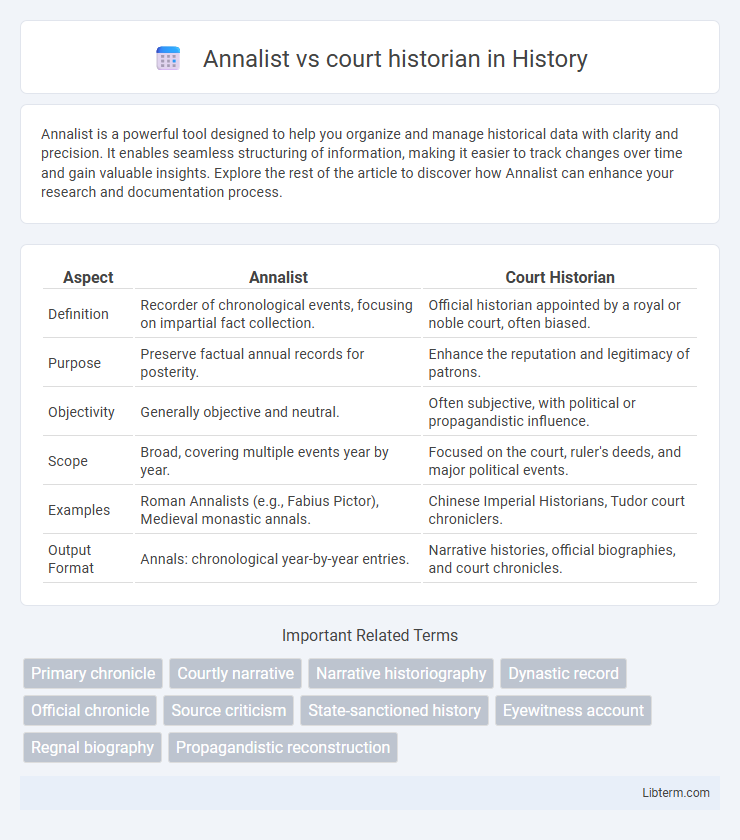Annalist is a powerful tool designed to help you organize and manage historical data with clarity and precision. It enables seamless structuring of information, making it easier to track changes over time and gain valuable insights. Explore the rest of the article to discover how Annalist can enhance your research and documentation process.
Table of Comparison
| Aspect | Annalist | Court Historian |
|---|---|---|
| Definition | Recorder of chronological events, focusing on impartial fact collection. | Official historian appointed by a royal or noble court, often biased. |
| Purpose | Preserve factual annual records for posterity. | Enhance the reputation and legitimacy of patrons. |
| Objectivity | Generally objective and neutral. | Often subjective, with political or propagandistic influence. |
| Scope | Broad, covering multiple events year by year. | Focused on the court, ruler's deeds, and major political events. |
| Examples | Roman Annalists (e.g., Fabius Pictor), Medieval monastic annals. | Chinese Imperial Historians, Tudor court chroniclers. |
| Output Format | Annals: chronological year-by-year entries. | Narrative histories, official biographies, and court chronicles. |
Introduction to Annalists and Court Historians
Annalists are ancient historians who recorded events year by year, emphasizing chronological order and factual accuracy, often used in early Roman and Greek traditions. Court historians, by contrast, served royal or noble patrons, blending historical records with propaganda to legitimize and glorify their rulers' reigns. Both roles contributed to preserving history, but annalists prioritized objective event listing, while court historians framed narratives to support political agendas.
Defining the Annalist: Role and Responsibilities
An annalist is a historian who compiles annual records, focusing on chronological documentation of events to preserve a continuous historical narrative. Unlike a court historian, whose role is often influenced by royal patronage and emphasizes glorifying a ruler's achievements, the annalist aims for impartial and systematic event recording. Responsibilities of an annalist include gathering diverse sources, maintaining accuracy, and providing context to ensure the reliability of historical accounts over time.
Understanding the Court Historian: Functions and Influence
The court historian functioned as an official chronicler, preserving the reign's narratives, decisions, and cultural heritage with authoritative insight. Their influence extended beyond mere record-keeping by shaping historical interpretation, legitimizing rulers, and reinforcing political agendas through curated accounts. Unlike annalists who compiled straightforward chronological records, court historians crafted nuanced narratives reflecting power dynamics and ideological priorities within the court.
Origins and Historical Context of Annalists
Annalists originated in ancient Rome as early chroniclers who systematically recorded yearly events, providing foundational historical accounts for the Republic and early Empire. Their work focused on documenting facts and public events in chronological order, contrasting with court historians who often produced biased, glorified narratives to support imperial propaganda. Annalists' records, embedded in the socio-political context of Rome's development, remain critical primary sources for understanding the Republic's formative centuries.
Evolution and Importance of Court Historians
Court historians evolved from ancient annalists by shifting from simple yearly record-keeping to comprehensive narratives that reinforced royal authority and legitimacy. Their role expanded to include interpreting events, shaping historical memory, and advising rulers on political strategy through carefully curated accounts. The importance of court historians lies in their influence on preserving dynastic legacy and shaping national identity by providing authoritative perspectives on historical events.
Methodologies: Annalist vs Court Historian
Annalists employ a chronological methodology, recording events year by year to provide an objective, continuous historical account focused on factual accuracy and comprehensive coverage. Court historians adopt a narrative-driven approach, emphasizing the achievements and perspectives of rulers, often intertwining political agendas with historical events to legitimize authority. The annalist's method prioritizes impartial documentation, whereas the court historian's approach is selective and interpretive, shaped by the needs of the patron or royal court.
Objectivity and Bias in Historical Recordkeeping
Annalists often emphasized objective, chronological recording of events, striving to maintain neutrality and minimize personal bias by documenting facts as they occurred. Court historians, however, frequently incorporated political agendas, highlighting the ruler's achievements and justifying their actions, which introduced significant bias into historical narratives. The contrast between annalists and court historians illustrates the tension between impartial historical recordkeeping and the influence of power in shaping historical accounts.
Impact on Historical Narratives and Public Perception
Annalists, by recording annual events in a factual and chronological order, provide a structured but often limited scope on history, while court historians shape narratives through selective storytelling that supports ruling elites, significantly impacting public perception. The annalist's emphasis on objective record-keeping tends to preserve a more balanced account, though sometimes lacking in deeper context or interpretation. In contrast, court historians influence historical narratives by legitimizing power and ideology, often creating a lasting cultural memory that favors specific political agendas.
Case Studies: Notable Annalists and Court Historians
Prominent annalists such as Tacitus meticulously documented events year by year, providing structured chronological accounts that offer valuable insights into Roman history. Court historians like Suetonius combined access to imperial archives with narrative flair, producing detailed biographies that reveal the personalities and politics within royal courts. Case studies highlight how annalists prioritized factual chronology, while court historians emphasized interpretive storytelling, each shaping historical understanding in distinctive ways.
Conclusion: Comparing Legacies and Modern Relevance
Annalists documented yearly events with concise records, laying the groundwork for chronological history, while court historians crafted detailed narratives that shaped royal legacies and political propaganda. The legacy of annalists lies in their objective approach to recording facts, influencing modern historiography's emphasis on evidence-based history, whereas court historians' works provide insight into the cultural and political contexts of their eras. In contemporary scholarship, annalists' methods support critical historical analysis, while court historians' accounts remain valuable for understanding the interplay of power and historical interpretation.
Annalist Infographic

 libterm.com
libterm.com